Even though the first rumours had started years ago, Ivan Rakitić’s transfer away from Barcelona was finally confirmed yesterday afternoon. The Croatian will return to his beloved Sevilla and continue playing his football in LaLiga for the upcoming 2020/21 season.
And even though he’s on the wrong side of 30 already, Rakitić is a player that can still offer Julen Lopetegui’s side quite a lot. This tactical analysis will give you a scout report of the player and tell you how exactly can he fit Sevilla’s tactics.
The deep-lying distributor
Sevilla are a very peculiar team. Of course, with Lopetegui at the helm, it doesn’t exactly come as a surprise to see that they are indeed a squad that focuses on possession but are also more traditional in a sense that most of their chances come from crossing and quick transitions.
Still, the Andalusians’ midfield, albeit not the fulcrum at all times, is a very important part of those tactics. Generally speaking, they can be divided into more generic roles as a creator, destroyed and wide-sprayer or distributor in a formation that usually resembles a 4-3-3 on paper. Lopetegui likes to keep the ball and recycle it until a gap appears up front.
This means Sevilla are not exactly a heavy positional team but rather more opportunistic and direct once that chance finally arises. When building-up their attacks, this structure often naturally transitions into a 3-4-3 or even a 4-1-4-1, often with the pivot dropping in-between the centre-backs to form that back three.
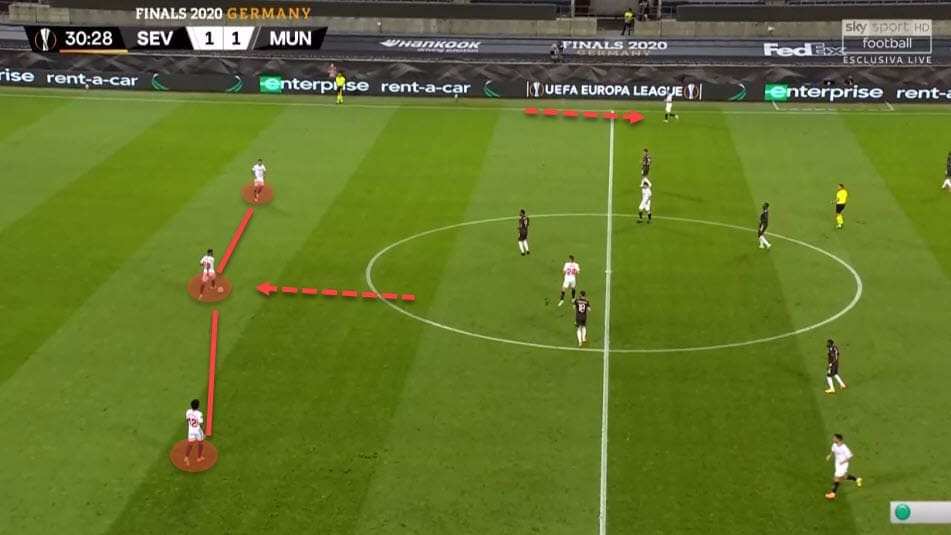
You can see a usual setup in such a scenario in the image above. The pivot, usually Fernando for the majority of the season, will drop deep, pushing the full-backs high and combining with their respective wingers and midfielders.
With 466.9 passes per 90 minutes and 56.9% possession amassed throughout the season in 2019/20 on average, only Real Madrid and Barcelona edge them out in both categories while Real Sociedad have recorded marginally better possession percentage as well. This tells us that they are indeed a possession-based team.
Upon further analysis, we can see that this suits Rakitić perfectly. The Croat is mostly deployed on the right side of a midfield trident at Barcelona but has seen his role drop deeper over the years at times. Now, with his legs slowly getting more tired and with his natural lack of pace, that deeper role is definitely what could suit him at Sevilla as well.
Below, we can see Rakitić dictating play in a pivot role himself, substituting for the missing Sergio Busquets and staying near the defensive line. This is a position he could occupy at his new (old) club, pulling the strings from the deep.
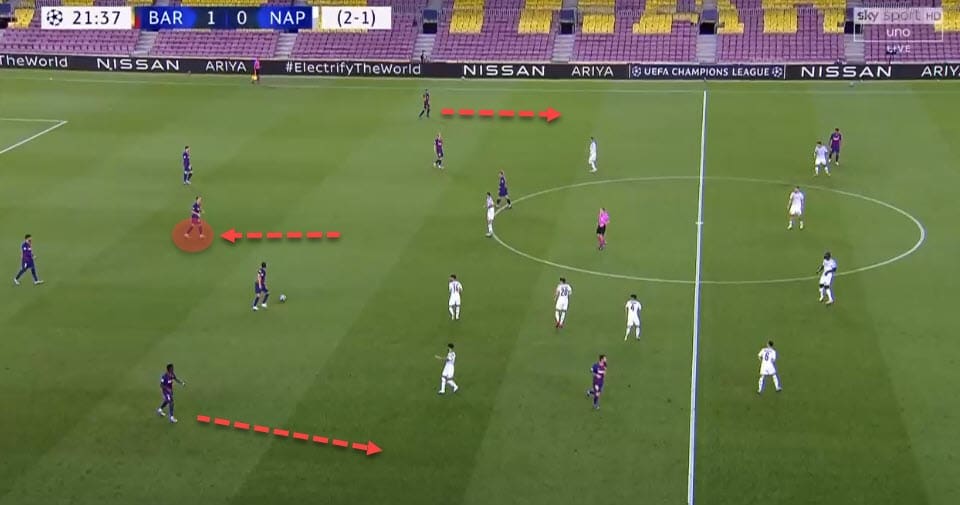
One of his best attributes is definitely his distribution. Rakitić is known for being able to distribute long balls from deeper or more advanced areas, often serving the purpose of switching play and/ or sending the pacey teammates into space.
Below, we have outlined all of LaLiga midfielders who have played at least 500 minutes in the 2019/20 campaign and their long passes per 90 and general passes per 90 minutes. Sevilla’s midfielders and Rakitić are highlighted so we can see how the Croat stacks up against his future teammates.
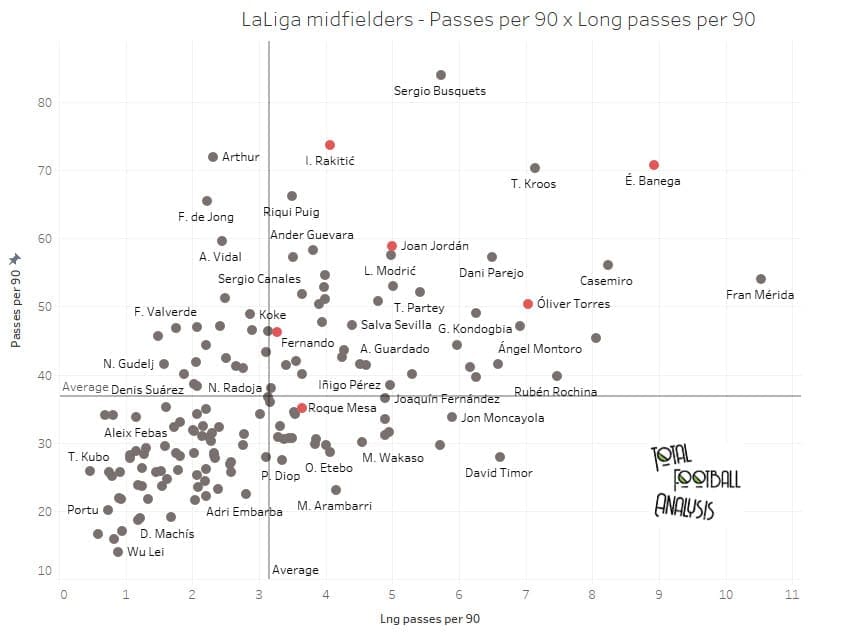
Obviously, with Barcelona not putting much emphasis on long ball switches, the Croat is slightly behind the likes of Éver Banega, Joan Jordán and Óliver Torres, all of whom eclipse his 4.07 long passes per 90 minutes.
However, out of all of Lopetegui’s midfielders, none are as good at ball-recycling as Rakitić. Only Banega comes close to the Croat’s 73.73 passes per 90 minutes – which is indeed the second-best figure across the whole league – but the Argentine is now officially leaving the club.
So why exactly is this a heavily important aspect? We have already concluded that Sevilla, albeit heavily possession-based, are not overly positional. Those two often go together but can also be parts of different kind of tactics. Recycling the ball in the backline to invite pressure and then bypass it is a more direct way of using possession as a tool to advance play.
Rakitić can provide that perfectly. Once the opposition is drawn in and their structure becomes more open, Sevilla eject their pacey wingers and/ or full-backs into the space beyond the defensive line. We can see a similar example of that below.
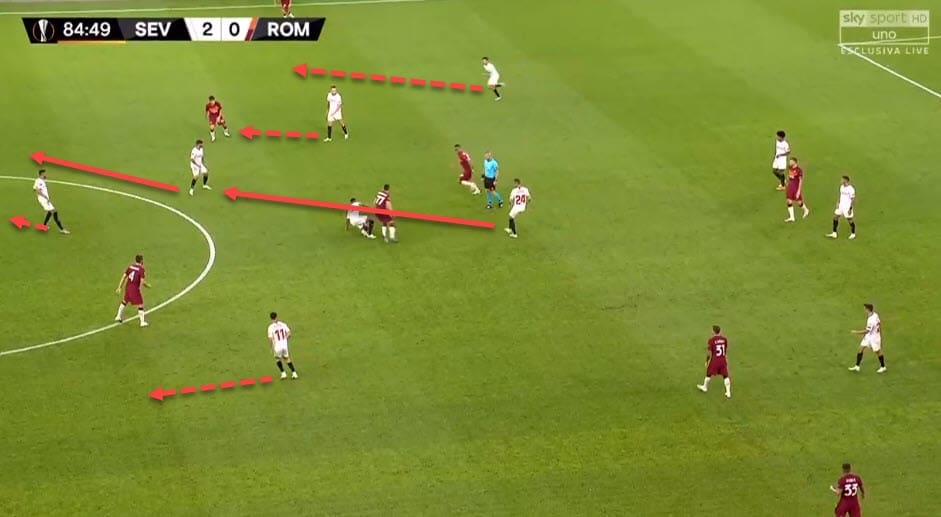
Roma are collapsing onto the Andalusians after losing the ball but Sevilla have the mechanisms to immediately escape that pressure and exploit the free space that has suddenly appeared behind their backs. One can surely imagine Rakitić in a deeper position deploying the long balls towards his teammates.
Notice in that same example how Sevilla have multiple players already starting their runs for a successful transition. While at Barcelona, Rakitić was surrounded with players of perhaps better technical quality, Sevilla offer pace, energy and verticality in movement. The Croat will definitely enjoy that and so his skillset suits it brilliantly.
Of course, these switches can be done either through a centre-back going immediately over the top and into the opposition’s half with a long ball or through a more complicated interplay that involves some degree of positional play. Either way, Rakitić can use his passing range to send the likes of Navas, Reguilón, Suso or Ocampos running into space. We can see an example of that kind of a switch below.
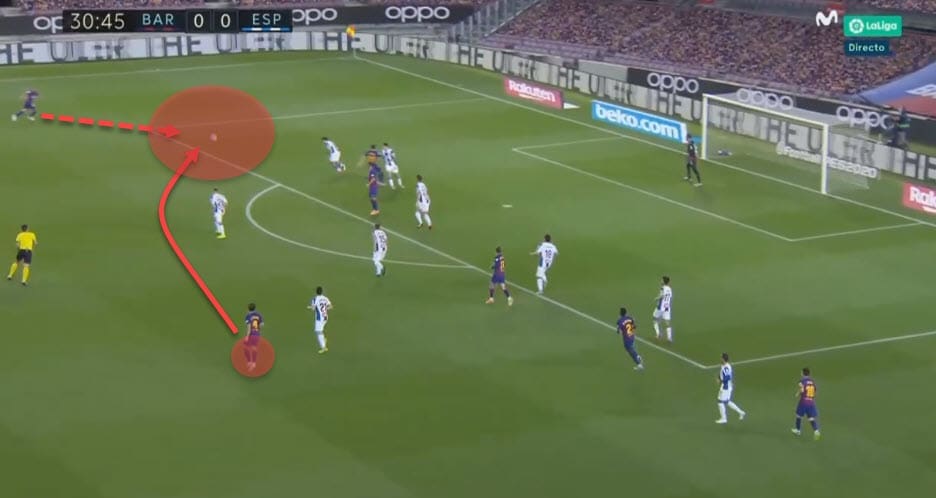
Barcelona have attracted Espanyol’s defensive structure to the right and then use Rakitić to quickly swap sides and eject Jordi Alba into space on the other flank. This is a common sight at Sevilla as well since they tend to invite pressure towards their own half and then deploy passes in-behind quickly.
Similarly, Lopetegui’s team likes to start these switches and space exploitations through turnovers and following successful recoveries. If he is to be deployed in a deeper role, perhaps playing as the lone pivot near the defensive line or in-between the centre-backs, Rakitić will also have to be able to break up opposition’s advances.
Below, once again, we have outlined all LaLiga midfielders’ successful defensive actions per 90 and possession-adjusted interceptions to see whether he’d be a good fit there as well. Rakitić and Sevilla midfielders are once again highlighted with the colour red.
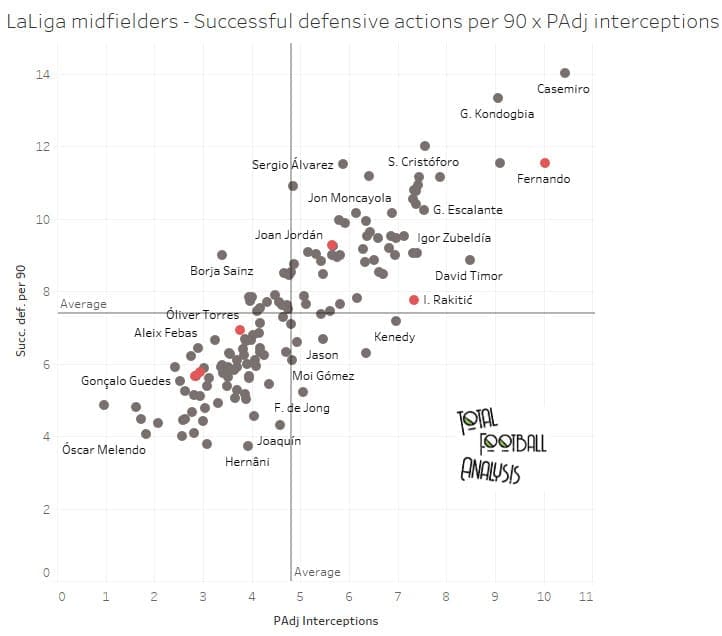
Of course, Sevilla’s destroyer Fernando is among the very top in this category so it wouldn’t be such a shock to see him retain the pivot position for himself. But Rakitić is right behind him in PAdj interceptions (7.34) and just behind both Fernando and Jordán in terms of successful defensive actions per 90 (7.76).
Whether it’s in a role of a distributor from the back or a midfielder to start the turnovers and then send his teammates into space, it does seem like a deeper role would indeed suit Rakitić and Lopetegui’s tactics.
But even though he has the predispositions for that, he has been used as a box-to-box midfielder for the majority of his stay at Barcelona.
The box-to-box midfielder
When attacking, Sevilla have a very distinctive approach. Of course, the wide areas are their highest priority when progressing the ball and the main source of attack. But in players like Banega and Franco Vázquez they have midfielders who can contribute to the attack either through their movement or passing.
One of the usual tactics they use combined alongside the aforementioned systems is by swapping the positions of certain players. Movement and fluidity are key here and we’ll often see the wingers like Ocampos and Suso dropping through their respective half-spaces to receive the ball and then lay it off.
In those scenarios, one of the midfielders will often take their place and move up the pitch and into the space left behind by their teammate. This type of movement puts the defenders in a decisional crisis because they don’t know whether to follow the dropping winger or cover the incoming midfielder.
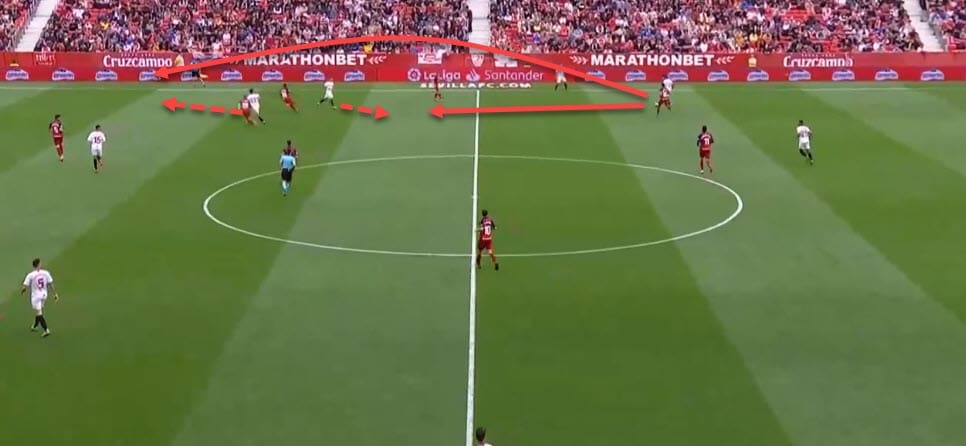
You can see an example of that swap in the image above. And apart from confusing the opposition’s backline, this interchange also gives Sevilla an option to either go long directly into the open channel or short into the feet of the dropping winger.
This is of course where Rakitić can be extremely useful going both ways. Of course, we have already established that his long balls over the top are an effective way to advance the play but he is also the type of player who can make those runs himself.
Ernesto Valverde was the one who often had the Croat make those runs, even starting him as a wide midfielder at times. This is due to his ability to either create space for others through his movement or exploit it himself.
Notice below how Rakitić makes a run forward towards the opposition’s box and switches places with Lionel Messi. This is just one of the ways he can be deployed as an advanced midfielder that suits what Sevilla are doing in their tactics already.
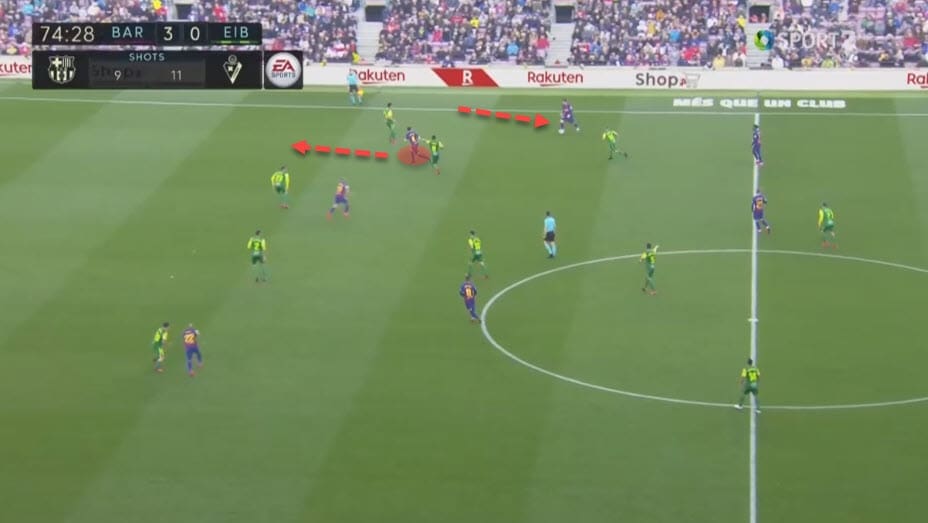
And while he is not one blessed with a lot of pace, the Croat still has the legs to burst forward and add more attacking power to his team’s advances. This is a sign that he can easily be a true box-to-box midfielder, defending in his own area in one instance and then bursting forward in the other.
For Sevilla, this could be crucial if he is to be played in a more advanced role, away from the pivot/ deeper position. There, we can definitely expect him to swap places with the wingers who drop to receive. And then, the Andalusians will aim to eject their players into space.
Below, we can see one example from Valverde’s era as Rakitić makes a late run into the box, giving his teammate an additional outlet to exploit in the danger area.
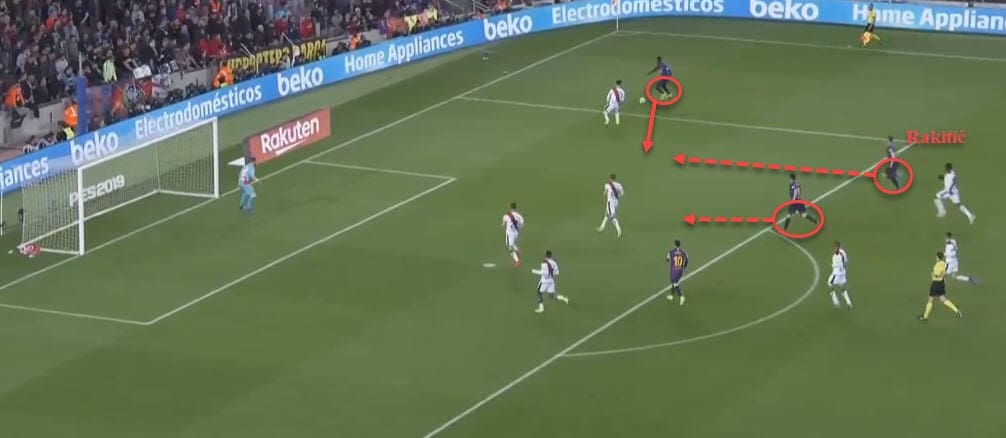
Of course, apart from making those late runs and even creating space through them, the Croat can be a direct threat on goal as well. Out of all Barcelona midfielders, he was the only one besides Arturo Vidal who carried a genuine danger for the opposition’s goal in terms of pure goal-scoring output.
In 2019/20, he was shooting more often with his shots per 90 minutes in all competitions rising from 1.41 in 2018/19 to 1.71 in 2019/20 but with a slight drop in accuracy (29.8% to 25%). So his long-range efforts still carry a certain value if a deep block cannot be breached through other means.
Banega replacement?
As soon as the Rakitić news was official, many people’s first thought was that the Croat could indeed replace Banega in the team. It has to be said, however, that it’s highly unlikely that the former Barcelona man can fill in the Argentine’s shoes effectively simply because they are different players altogether.
Banega was a playmaker, a creative force and the hub of Lopetegui’s team. Rakitić, for all his qualities, thrives in different areas. Of course, we may see him deployed closer to the opposition’s box if they go back to the roots but with him ageing and reverting to a different playstyle to the one he enjoyed five or six years back, it’s likely he won’t be their no.10.
Just for comparison’s sake, we have decided to crunch the numbers and see how Banega and Rakitić stack up against one another. We will do this through three main categories presented in a series of graphs: attacking, defending and passing.
The first one will deal with attacking and creativity, something Banega clearly excels at and was one of Sevilla’s main contributors in that area.
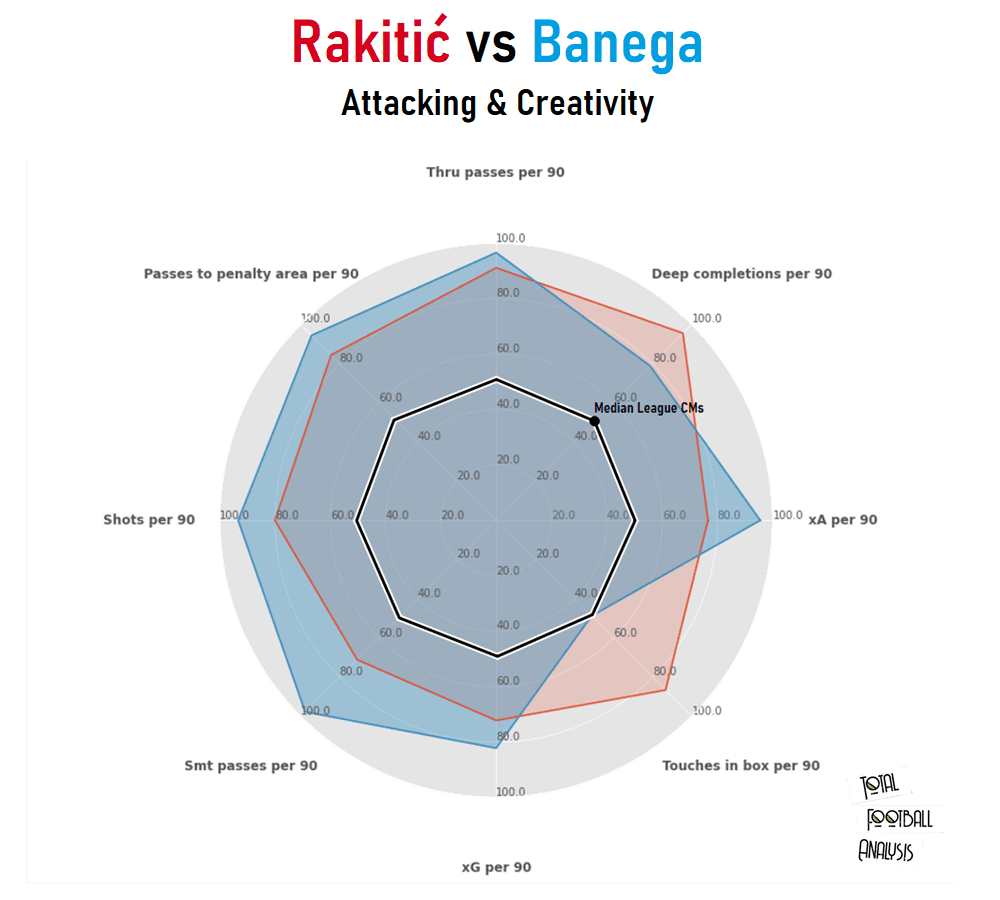
While both players are clearly way above the medium percentile rank for all midfielders in LaLiga, Banega seems like the more creative of the two, edging Rakitić out in terms of through ball, passes to the penalty area, shots per 90, smart passes, expected goals and expected assists. When it comes to creation, the Croat lags behind the Argentine quite a bit.
However, we can clearly see that Rakitić has that final third presence with the late runs into the box we’ve mentioned and can also be dangerous with his deep completions in the final third of the pitch.
When it comes to passing, they are once again different profiles altogether. We can see that Rakitić is the perfect choice to keep and recycle possession as his passing accuracy, passes per 90 minutes, forward passes accuracy and even final third passing accuracy are among the best in the league.
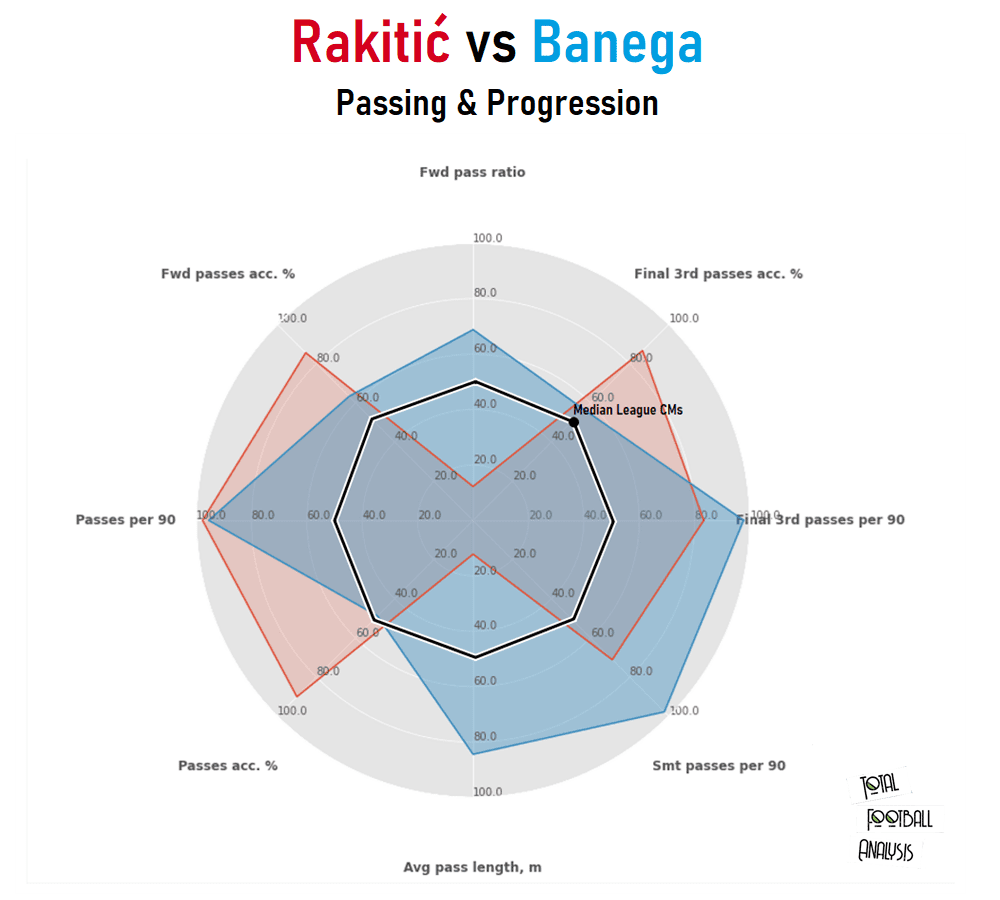
Banega, on the other hand, is the riskier passer of the two, always looking to progress the ball forward, often through long passes, and relies on smart passes as well. Of course, the stark contrast in their pass length is also a reflection on their teams’ style of play. At Barcelona, Rakitić rarely had to go long as the Catalans preferred the slower approach through short passes.
All of that, however, would mean that he won’t exactly be able to replace Banega’s output if put into a more advanced role on the pitch. He has the predisposition for a more offensive approach but it does feel like the player Barcelona have moulded over the years would be better off in a much deeper position.
Finally, we’ll touch upon their defensive output.
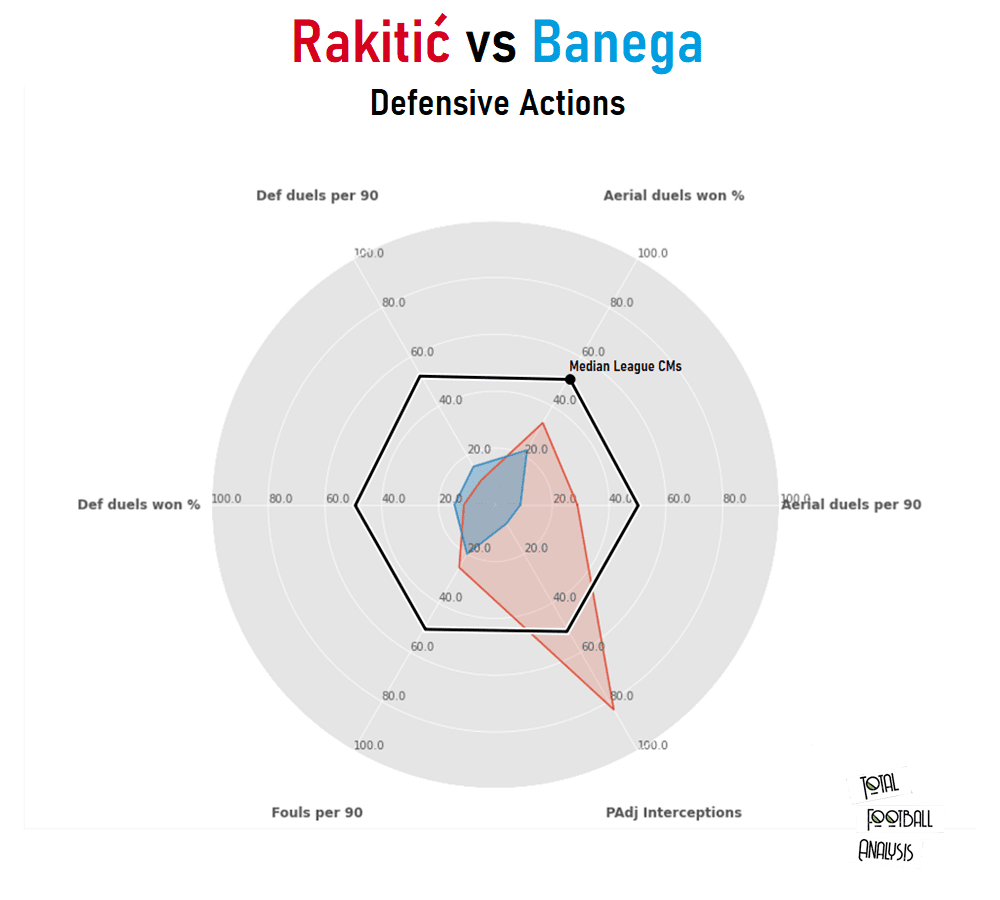
We can clearly see that neither of them is a defensive machine but Rakitić is much better in the air and is excellent at intercepting the opposition’s passes and in ball recoveries in general. He eclipses Banega’s output here in those categories but lags marginally behind the Argentine in defensive duels per 90 and defensive duels won.
However, in a system that relies on turnovers and transitions that are arise from those situations, his interceptions and recoveries in the opposition’s half are an excellent addition. Rakitić averaged 2.4 recoveries (0.78 in opposition’s half) to Banega’s 1.91 (0.51).
Not only that but with him on the pitch, the opponent’s xG drops to 0.61 while Banega’s presence keeps it at around 0.74 per 90 minutes.
Final remarks
Even though it does feel like a largely sentimental move for both Rakitić and Sevilla, mostly because the player could’ve secured a transfer to the Premier League or to Paris Saint-Germain a couple of seasons before, there is still some value in it.
The midfielder can be deployed in both a deeper and more advanced role to great effect and while he won’t exactly be able to be a like for like replacement for the departing Banega, the Croat can still fit Lopetegui’s tactics and help the Andalusians make a step forward next season.






Comments